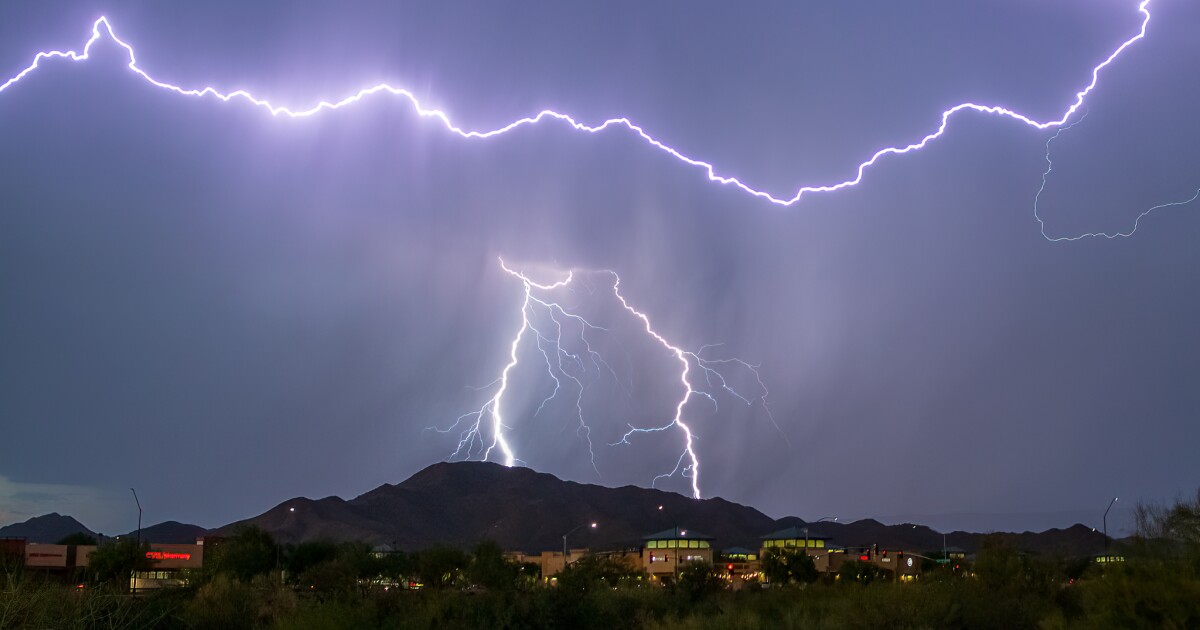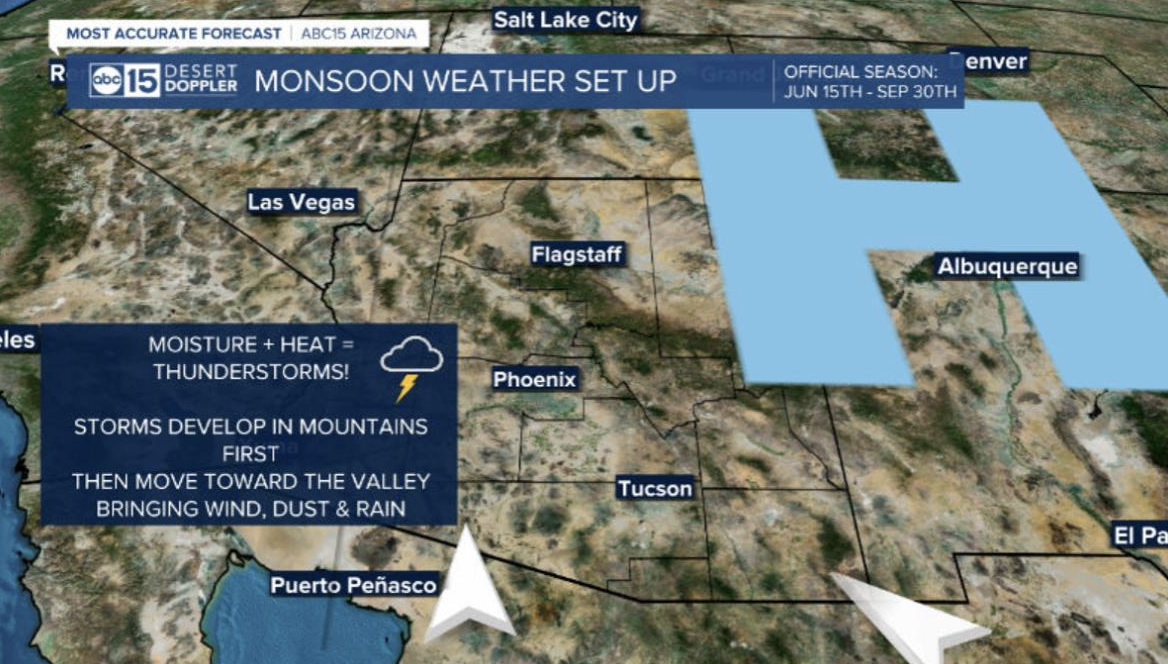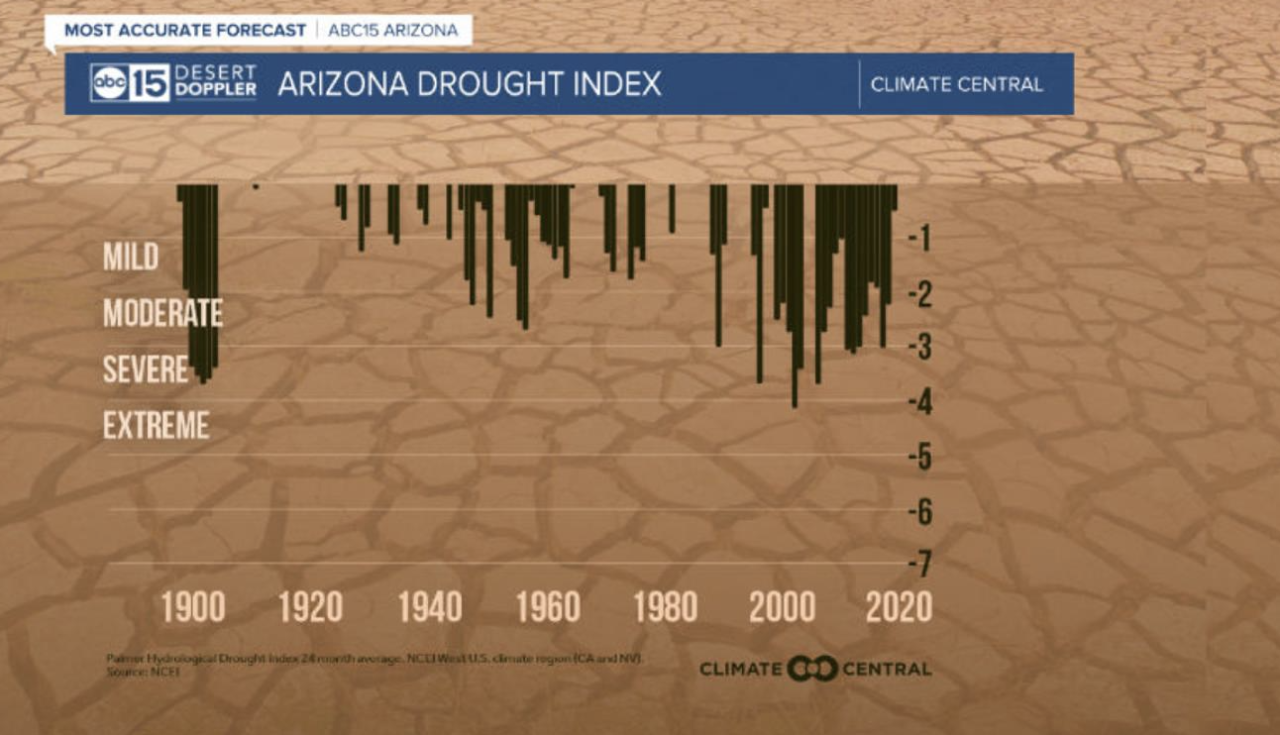Arizona
Arizona Senate Republicans advance controversial border ballot measure

Bridget Dowd/KJZZ
The Arizona Senate building in Phoenix.
A border security ballot measure advanced through the Arizona Senate on Wednesday on party lines with amendments that Republicans say will ensure no one is racially profiled under the proposal.
The legislation, HCR 2060, would make it a state crime to enter Arizona from Mexico outside of a designated port of entry. That’s already illegal under federal law, but can’t be locally enforced.
The measure is based on a Texas law, SB 4, that is currently blocked from going into effect, as it’s being challenged in court.
Democrats have likened the measure to SB 1070, a controversial immigration law passed in 2010 that was commonly known as the “show me your papers” bill. That law sparked months of protests, and portions of it were later struck down in court.
HCR 2060 is similar to a bill Republicans passed earlier this year, only for it to be vetoed by Democratic Gov. Katie Hobbs. Republicans now aim to bypass the governor’s veto stamp by referring the measure to Arizona voters this November.
But the Senate’s approval is not the last step – the new measure goes next to a vote in the House of Representatives, which isn’t scheduled to convene again until the beginning of June.
And even if approved by the Senate, House and voters, the measure also cannot take effect unless Texas’ SB 4 is cleared in court.
The Senate only approved the measure after adopting several amendments insisted on by Sen. Ken Bennett (R-Prescott). Every Democrat in the Senate opposed the bill, and Republicans only hold a one-seat majority in the Senate – meaning Bennett held the crucial 16th vote needed to move the measure forward.
Bennett objected to part of the bill that would have allowed law enforcement officers to deport recipients under the Deferred Action for Childhood Arrivals program, in the event a future administration or court order canceled the program.
While voting, Bennett said he was satisfied with an amendment that states the proposal will go into effect prospectively, and will not affect anyone who has been in the country illegally or otherwise if and when the law goes into effect.
Bennett also praised language GOP supporters say will prevent racial profiling under the proposal.
“I’ve done everything I can at this point to make sure that doesn’t happen,” Bennett said before the vote.
But Democrats said their concerns that the measure will be weaponized and used for racial profiling were not satisfied by the amendment. Sen. Rosanna Gabaldón (D-Tucson) spoke about her experience under SB 1070, warning the same could happen under this new proposal.
“Each time that I was stopped, I asked why. Majority of the time, they said, ‘no, prove your citizenship,’ or something like that,” she said. “They didn’t tell me how I broke the law. To me, I believe they didn’t have probable cause, stopping me because of what I looked like.”
Tensions ran high, as debate on the measure lasted more than four hours.
The amended measure states that law enforcement can only arrest someone if they witness them crossing the border illegally, if there is a technological recording of the crossing or if there is “any other constitutionally sufficient [signs] of probable cause.”
It’s the third, more vague explanation of probable cause that Democrats said could be abused. Sen. John Kavanagh (R-Fountain Hills) argued in favor of that third definition, insisting there are other ways to get probable cause that someone has crossed the border illegally, such as a confession.
“Criminals are stupid,” Kavanagh said, eliciting gasps from onlookers in the Senate gallery opposed to the proposal.
“I’m sorry if I offended any criminals in the gallery,” he added.
That comment led to a heated exchange between Kavanagh and Sen. Catherine Miranda (D-Phoenix), who accused him of racial profiling, which he denied and requested an apology for.
Miranda later warned that, like in Texas, this measure will be challenged if it passes and will ensnare the state in an expensive legal process. She cited warnings from the Senate’s own lawyers that the measure may be unconstitutional and could also violate Arizona statute that requires ballot referrals to cover a single subject.
Miranda argued a different part of the ballot referral that includes enhanced sentencing guidelines for a person found guilty of knowingly selling fentanyl that causes the death of another person violates that restriction.
Sen. Christine Marsh (D-Phoenix) also objected to the fact that the measure refers to fentanyl. Marsh argued that it won’t stop that drug from hurting Arizonans, citing Border Patrol figures that show most fentanyl trafficked into the country is being moved by legal residents through official ports of entry.
“This bill will not solve the fight against this crisis,” Marsh said. “It makes it appear falsely that there’s already a solution to the crisis.”
The bill was also amended to say that someone who chooses to “self-deport” could go back across the border into Mexico, or to their “country of origin” if it is not Mexico.
Senate Minority Leader Mitzi Epstein (D-Tempe) questioned how that will be enforced. She and other Democrats also questioned how much the measure will cost the state since it doesn’t include any appropriation of funds.
Republicans did not have specific answers to that criticism. Sen. David Gowan (R-Sierra Vista), the bill’s sponsor, only said that those charged under the law would be financially responsible for self-deporting.
Roughly halfway through the proceedings, Sen. T.J. Shope (R-Coolidge) was interrupted by protesters with LUCHA, an advocacy group opposed to the measure, who yelled “Stop the hate,” and cursed at Republicans before being escorted out by security.
Sen. Anna Hernandez (D-Phoenix) said that not only is she concerned about racial profiling, but how individuals who believe they are victims of that treatment will hold law enforcement accountable.
She drew attention to a section of the bill that grants law enforcement officers civil immunity if they are sued for enforcing the law.
“What legal recourse will they have?” Hernandez asked the room.
Senate President Warren Petersen (R-Gilbert) rejected that criticism, saying the immunity clause applies to issues at the state level, not alleged violations of federal Civil Rights laws.
→ Get more Arizona politics news


Arizona
‘If you fly, we can’t’: Why you can’t fly drones near wildfires in Arizona and elsewhere

Ironwood Fire burns near Interstate 17 at Cordes Junction
A wildfire erupted after a motor home with ammunition caught fire, causing the shutdown of the northbound lanes of I-17 on June 14, 2024.
Wochit
Operations to help clear the Ironwood Fire were temporarily put on hold Friday evening due to a drone in the area, according to a post on X by the Bureau of Land Management’s Arizona Fire Management.
The Ironwood Fire started about 4 p.m. Friday after a motor home caught fire and ammunition inside exploded, according to the Arizona Department of Public Safety.
The northbound lanes of Interstate 17 were temporarily shut down and officials said the fire was completely contained by Saturday morning.
“If you fly, we can’t,” the graphic on the post reads. “Recreational drones near wildfires are not safe.”
Here is what to know about why drones cannot be flown in forest fire zones.
‘If you fly, we can’t’ campaign
According to the U.S. Forest Service, “If you fly, we can’t,” stresses the public not to fly drones near or over wildfires.
The agency said federal, state and local wildland fire management agencies, along with the Federal Aviation Administration, urged the public not to fly drones near or over wildfires because they pose “serious risks” to public safety personnel and alter the effectiveness of those fighting wildfires.
The agency said aircraft that fight fires fly only a couple hundred feet above the ground, at the same altitudes as drones. This could create the potential for a midair collision or a distraction for the pilot, which could result in fatalities. Unauthorized flyers could also fall from the sky and cause serious injuries or death to firefighters on the ground.
The Forest Service said suspending firefighting operations could allow wildfires to grow larger and threaten lives, property and valuable resources.
During 2019, the service documented at least 20 instances where unauthorized drones were flown over or near wildfires, including in Arizona. These instances resulted in firefighting operations having to shut down temporarily nine times.
Flying a drone near a wildfire and interfering with wildfire efforts could lead to civil penalties, including fines up to $25,000 and potential criminal prosecution, according to the Forest Service.
Wildfire map: Track where fires are burning in Arizona in 2024
Arizona
Analyst: Former Cardinals WR Set for Bounce-Back Season

ARIZONA — The Arizona Cardinals didn’t quite maximize the talents of WR Marquise Brown during his time in the desert, though new beginnings could see Hollywood’s lights shine with the Kansas City Chiefs.
Brown was acquired for a first-round pick on draft night a few years back, and the hope was he and former Cardinals WR DeAndre Hopkins could form a dynamic duo for Arizona to lean on for years.
That didn’t come to fruition, and now Brown finds himself on a back-to-back Super Bowl winning team with Patrick Mahomes throwing him the ball.
There’s plenty of reason to expect Brown to bounce back in 2024, says PFF – at least in terms of fantasy football production.
“Playing through injury for the Arizona Cardinals last year, the Kansas City Chiefs‘ new field-stretching wide receiver Marquise Brown delivered half-PPR and PPR WR5 results in both season-long and per-game scoring. Fantasy managers should expect Brown to bounce back via positional top-36 results operating as Kansas City’s largely uncontested deep threat,” wrote Nic Bodiford, who explored Brown’s volume target totals after going through the various names Kansas City failed to replace Tyreek Hill with.
“Brown has efficiently earned high-volume target totals in each of the last four years despite regularly running routes past the sticks. His catch rates leave some to be desired but his 2023 down year inaccurately reflects his moderate surehandedness.Among 34 NFL wide receivers with at least 280 targets from 2020-to-2022, Brown’s 64.5% catch rate ranks 25th.
“Kansas City quarterback Patrick Mahomes is a notable upgrade on Brown’s former starting quarterbacks, Baltimore Ravens Lamar Jackson and Arizona Cardinals Kyler Murray. … Fantasy managers should expect Brown to bounce back as a WR3 or better in 2024.”
Even in the realm of actual football, there’s reasonable belief that Brown can emerge as a top weapon in Kansas City despite the presence of others around him. Mahomes has an arm like no other quarterback, and if Brown can remain healthy in 2023, the Chiefs may have gotten a steal on the market.
Arizona
How Arizona's monsoon is changing

PHOENIX — Each summer, thunderstorms tower in our otherwise sunny Arizona sky. Winds shift out of the south and southeast, bringing moisture in all the way from the Gulf of Mexico. That moisture rises and forms thunderstorms in the heat of the day. This is our monsoon.
Much of Arizona typically receives 30 to 50 percent of its annual rainfall during the monsoon months of June, July, August, and September, which helps replenish our dry land and diminish wildfire threats.
UA
But, the monsoon as we know it is changing. As our atmosphere gets hotter with climate change, it’s able to essentially hold more water vapor and that’s altering how our monsoon behaves.
“We don’t get as many storms, but when they do come, they’re tending to produce higher rainfall amounts, more intense rainfall, and more intense winds,” says Dr. Christopher Castro with the Hydrology and Atmospheric Sciences Department at the University of Arizona.
That’s exactly what we saw play out here in Phoenix last summer. It was our hottest and driest monsoon on record. Sky Harbor only received 0.15 inches of rain. That’s more than 2 inches below normal.
But, what is considered a “normal” amount of monsoon rain has changed a lot in the past 50 years.
Every 10 years, new normals are calculated based on a rolling 30-year average. Our latest update came in 2021, giving us a new average that is based on rainfall data from 1991 to 2020.
This new normal showed an average rainfall in Phoenix for the monsoon season of 2.43 inches of rain. That’s more than a quarter of an inch drier than the previous average, which is a big difference here in the desert!

KNXV
Castro and his team at the University of Arizona are leading the way when it comes to research on how climate change is impacting our monsoon. Although not yet published in scientific peer-reviewed journals, they have run experiments simulating how storms move down into the Valley.
They have discovered that a greater number of green spaces, like parks, golf courses, and green landscaping, are leading to fewer storms making it down into the city.
“The presence of all these watered areas is suppressing the amount of instability in the atmosphere. So, it’s harder to initiate storms from the outflow boundaries,” he says.
So, as storms try to move down off of the Mogollon Rim, they are now often getting diverted around the periphery of the Phoenix metro instead of rolling right through it like they used to.
Scientists like Castro have also seen a broadening of our monsoon ridge, which is impacting our monsoon, too.
KNXV

It’s the ridge of high pressure, which sets up near the Four Corners during the summer, that allows monsoon moisture to flow in.
“What we’ve observed in the last 20 years or so, is that the monsoon ridge is growing more intense and more spatially expansive. The bigger and more expansive that ridge is, the more propensity there is for the air to sink from the upper atmosphere. So. it suppresses the atmospheric instability and it makes storms harder to form,” Castro says.
That’s exactly what happened last year. As that ridge of high pressure sat over Arizona, it suppressed storm formation and made it much hotter. Our 2023 monsoon season was the hottest and driest on record in Phoenix.

KNXV
2020 was also a so-called “non-soon” with only 2 days of measurable rain in Phoenix. That year, we received 90% of our monsoon rain (0.90 inches) in just 2 hours with one particularly bad storm the night of August 20, 2020.
Castro says that’s the fingerprint of climate change in the desert.
“It’s really about the extremes. The monsoon is, generally all the way around, getting more extreme. So, when we get our heat waves now those are more intense than they used to be and when it rains, it may not rain as frequently as it used to, but it tends to be more intense,” Castro says.
That intensity makes it harder for us to adapt.
When it’s extreme heat, we see more heat-related deaths. We had 987 heat-related deaths across Arizona last year. 645 of those happened in Maricopa County, mostly during the hottest and driest monsoon on record.
When it’s extreme rainfall, we see more flash flooding and complete destruction near wildfire burn scars since the charred ground can no longer absorb water.
“From the water supply perspective, it’s bad news for recharge of the groundwater table. If you’re drying out the soils and then realizing your precipitation with only a few intense events, more of that precipitation is likely to run off. There’s also a greater danger for wildfires to happen and that totally changes the characteristics of the permeability of the soil. Then, when it rains, that water will immediately wash off very similar to a landslide,” Castro says.
A bigger, broader monsoon ridge also deflects atmospheric disturbances, known as inverted troughs, from tracking through Arizona.
Those disturbances often serve as triggers to get widespread rain and thunderstorm activity going during the monsoon.
“The expanded monsoon ridge is suppressing the path of those inverted troughs more to the south, so the number of inverted troughs is decreasing. So, the frequency of big precipitation events is decreasing. But when they do occur, they’re occurring in a more moist environment that is favorable for heavier amounts of precipitation,” says Castro.
We’re seeing similar impacts across the country as the number of heavy downpours increases in this warming world.
KNXV

While downpours are increasing, periods of drought are increasing too.
Climate Central
So we are increasing both of these extremes as our climate changes.
Castro says, “We’re going into a world where we have these more dramatic swings in climate variability, whether it’s winter or summer. There’s been this term coined climate whiplash, you go from one extreme to another, either between seasons or within a season. This is devastating from the standpoint of climate and our resiliency to the natural climate because if we’re exceeding the ranges of which our natural and human systems can cope with these whiplash swings, you’re going to go from one year where a dam nearly fails because it’s flooded to a year of devastating wildfires and the ecosystem cannot recover.”
-

 News1 week ago
News1 week agoIsrael used a U.S.-made bomb in a deadly U.N. school strike in Gaza
-

 World1 week ago
World1 week agoFrance to provide Ukraine with its Mirage combat aircraft
-

 World1 week ago
World1 week agoWorld leaders, veterans mark D-Day’s 80th anniversary in France
-

 World1 week ago
World1 week agoRussia-Ukraine war: List of key events, day 833
-

 News1 week ago
News1 week agoNonprofit CFO Accused of 'Simply Astonishing' Fraud
-

 Movie Reviews1 week ago
Movie Reviews1 week agoInsane Like Me? – Review | Vampire Horror Movie | Heaven of Horror
-

 Politics1 week ago
Politics1 week agoGeorge Clooney called White House to complain about Biden’s criticism of ICC and defend wife’s work: report
-

 Politics1 week ago
Politics1 week agoNewson, Dem leaders try to negotiate Prop 47 reform off California ballots, as GOP wants to let voters decide
















